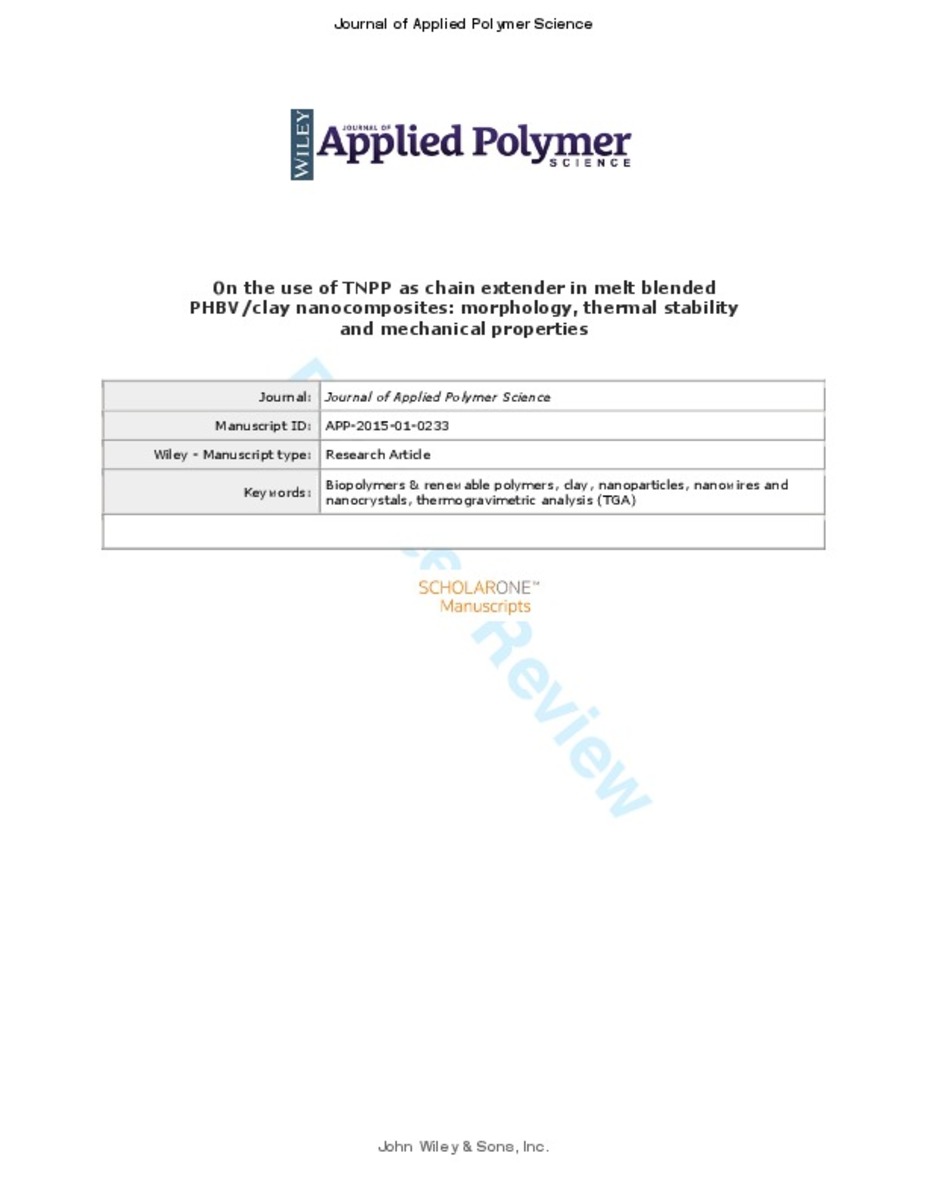Mostrar el registro sencillo del ítem
On the use of tris(nonylphenyl) phosphite as a chain extender in melt-blended poly(hydroxybutyrate-co-hydroxyvalerate)/clay nanocomposites: Morphology, thermal stability, and mechanical properties
| dc.contributor.author | González Ausejo, Jennifer | |
| dc.contributor.author | Sánchez-Safont, Estefanía | |
| dc.contributor.author | Gamez-Perez, Jose | |
| dc.contributor.author | Cabedo, Luis | |
| dc.date.accessioned | 2016-05-06T09:48:14Z | |
| dc.date.available | 2016-05-06T09:48:14Z | |
| dc.date.issued | 2015-06 | |
| dc.identifier.citation | GONZÁLEZ‐AUSEJO, Jennifer, et al. On the use of tris (nonylphenyl) phosphite as a chain extender in melt‐blended poly (hydroxybutyrate‐co‐hydroxyvalerate)/clay nanocomposites: Morphology, thermal stability, and mechanical properties. Journal of Applied Polymer Science, 2016, 133.2. | ca_CA |
| dc.identifier.uri | http://hdl.handle.net/10234/159353 | |
| dc.description.abstract | The influence of the incorporation of tris(nonylphenyl) phosphite (TNPP) as a chain extender on the morphology and thermal stability of poly(hydroxybutyrate-co-hydroxyvalerate) (PHBV)/clay nanocomposites obtained by melt mixing has been studied. Two different clays have been used: a laminar organomodified montmorillonite (Cloisite® 30B) and a tubular unmodified halloysite (HNT). The morphology of the so-obtained nanocomposites has been assessed by transmission electron microscopy, scanning electron microscopy, and wide angle X-ray diffraction, showing a partially exfoliated structure for PHBV/Cloisite® 30B nanocomposites, as well as a good dispersion of the HNT in the PHBV matrix. The crystallinity of the resulting nanocomposites, determined by DSC, does not change when clays or TNPP are added. An increase in the onset temperature of thermal degradation of PHBV has been obtained with the addition of TNPP, as determined by TGA. With regard to the effect of the nanoclays on the thermal stability of PHBV, the onset temperature of the PHBV/HNT nanocomposites is higher than that of the pure PHBV, while this trend is not observed for the nanocomposites containing Cloisite® 30B. The addition of TNPP to the PHBV/Cloisite® 30B nanocomposites resulted in an improved thermal stability; however, for the HNT nanocomposites, the TNPP does not seem to have a significant effect. For all studied systems, it was shown that the variation of mechanical properties of the nanocomposites is due to the reinforcing effect of the nanoclays on the PHBV matrix. In the case of TNPP, it is due to the increased molecular weight and formation of a long-chain branching structure. | ca_CA |
| dc.description.sponsorShip | Financial support for this research from Ministerio de Economía y Competitividad (project MAT2012–38947-C02-01), Generalitat Valenciana (GV/2014/123), and Pla de Promoció de la Investigació de la Universitat Jaume I (PREDOC/2012/32) is gratefully acknowledged. The authors are also grateful to Raquel Oliver and José Ortega for experimental support. | ca_CA |
| dc.format.extent | 31 p. | ca_CA |
| dc.format.mimetype | application/pdf | ca_CA |
| dc.language.iso | eng | ca_CA |
| dc.publisher | © 2015 Wiley Periodicals, Inc. | ca_CA |
| dc.relation.isPartOf | Journal of Applied Polymer Science,Volume 133, Issue 2, January 10, 2016 | ca_CA |
| dc.rights | Copyright © 2016 John Wiley & Sons, Inc. All Rights Reserved | ca_CA |
| dc.rights.uri | http://rightsstatements.org/vocab/InC/1.0/ | * |
| dc.subject | biopolymers and renewable polymers | ca_CA |
| dc.subject | clay | ca_CA |
| dc.subject | nanoparticles | ca_CA |
| dc.subject | nanowires and nanocrystals | ca_CA |
| dc.subject | hermogravimetric analysis | ca_CA |
| dc.title | On the use of tris(nonylphenyl) phosphite as a chain extender in melt-blended poly(hydroxybutyrate-co-hydroxyvalerate)/clay nanocomposites: Morphology, thermal stability, and mechanical properties | ca_CA |
| dc.type | info:eu-repo/semantics/article | ca_CA |
| dc.identifier.doi | 10.1002/app.42390 | |
| dc.rights.accessRights | info:eu-repo/semantics/openAccess | ca_CA |
| dc.relation.publisherVersion | http://onlinelibrary.wiley.com/wol1/doi/10.1002/app.42390/full | ca_CA |
Ficheros en el ítem
Este ítem aparece en la(s) siguiente(s) colección(ones)
-
ESID_Articles [464]







